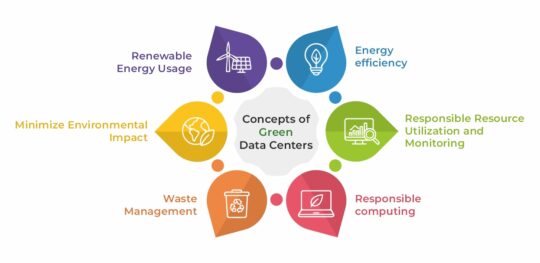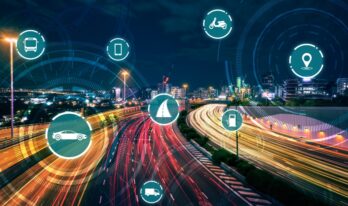As the adoption of IT, internet-based activities, and other digitalization aspects increases, so does the need for effective data storage and processing infrastructures, such as data centers. Notable to mention, the global data center market is progressing at a remarkable pace. This specific industry values worth $214 billion in 2023, which is set to surpass $406 billion by 2030.
Such growth will surely advance digitalization. However, it is important to consider sustainability while establishing data centers at present. It can have a negative impact on environmental responsibility due to high energy consumption, greenhouse gas emissions, and others.
Building green or sustainable data centers must be prioritized to tackle this challenge. In this blog, we will explore what green data centers are, their key concepts, techniques, benefits, and more, all with the goal of achieving a sustainable future.
Let’s get started...
What are Sustainable Data Centers?
Green data centers or sustainable data centers are servers or storage facilities that house IT infrastructure using energy-efficient technologies and renewable energy sources. These are determined to reduce the environmental impact of data centers, minimizing energy consumption, and carbon emissions.
In simple terms, green data centers emphasize the usage of natural resources and sustainable materials to fulfill the progressing digital services. All with an aim to operate in a more environmentally responsible way. Such an approach helps firms to advance their resource usage and embrace sustainability.
One of the examples of green data centers is Apple’s Maiden Data Center in North Carolina. It is possibly one of the largest data centers using 100% renewable energy.
Google is not behind in the race to achieve the breakthrough of becoming a carbon neutral organization in 2007 and operating with 100% renewable energy.
Environmental Impact of a Data Center:
Data centers require high power backup, a storage facility, and backup generators to function effectively. In case any of its key power elements are missing, interruptions, failures, and downtimes can take place, impacting the overall operations of a company’s IT infrastructure.
The operational requirements of data centers leave a great impact on the environment, questioning the factor of sustainability. Additionally, traditional data centers commonly relied on non-renewable resources that caused a larger carbon footprint. Below are the major setbacks data centers imposing on the environment-
Carbon Emission due to High Energy Consumption- As discussed previously, data centers need considerable energy and power to operate. Such high energy consumption often causes higher carbon emissions, leading to climate change.
Excessive Water Consumption- Data centers include an extensive cooling process that helps in managing temperature within servers. This cooling system requires a large water intake, which can cause exploitation of the local water resources.
E-Waste Generation- Hardware used in data centers needs time to time upgrades. This cause e-waste generation. E-waste can harm the environment through pollution and cause health risks.
Fundamental Concepts of Sustainable Data Centers:
Concepts of green data centers are the set goals and, in a broader sense, principles that companies aim to achieve through a sustainable approach. Here are the fundamental concepts to look after-
Minimize Environmental Impact- The primary objective of sustainable data centers is to reduce their negative environmental influence. For this purpose, it adopts responsible methods and technologies.
Energy efficiency- Green data centers aim at using limited power while maintaining higher performance, using energy-efficient technologies. Power usage effectiveness (PUE) and carbon usage effectiveness (CUE) are two major KPIs to indicate energy efficiency in data centers.
Responsible Resource Utilization and Monitoring- Green data centers intend for responsible utilization of natural resources like water and building materials.
Regulatory compliance- Data centers, prioritizing sustainability, adhere to the environmental regulations and guidelines.
Waste Management: Green data centers integrate thorough recycling methods and look for effective waste management. This reduces e-waste generation within data centers.
Responsible computing: These data centers pioneer responsible computing while optimizing resource usage and workloads. Such an approach contributes to the elimination of waste and the improvement of energy efficiency.
Renewable Energy Usage: Green data centers promote the implementation of renewable energy to reduce carbon emissions. As a result, they use wind, solar, and hydropower instead of fossil fuel.
Advantages of Green Data Centers:
The establishment of sustainable data centers can be beneficial for companies in many ways. Alongside sustainability, it helps brands to attain a competitive advantage. Below are the major advantages to discuss-
-
- Sustainability and Energy Efficiency- Green data centers promote the implementation and utilization of recyclable resources and technologies. Hence, it assists in advancing the sustainability commitment made by organizations.
- Cost Savings- Sustainable data centers enable firms to achieve significant cost savings. For this, it integrates low-power servers, responsible cooling systems, and efficient resource optimization.
- Positive Brand Image- Shifting to a sustainable approach reflects an organization’s commitment to sustainability and corporate social responsibility (CSR). Such steps can help in establishing a positive brand image while achieving a competitive advantage.
- Enhanced Compliance- Green data centers adhere to the environmental guidelines. Hence, these data centers also help organizations stay safe from penalties.
Key Techniques and Strategies of Sustainable Data Centers:
Efficient Infrastructure Design:
Sustainable data centers rely on an infrastructure with minimized physical space and efficient designs. Such infrastructures are often built with low-emission materials. Alongside materials, constructing a smart layout and design is crucial for lighting, air flow, and other factors that prioritize sustainability. Generating low construction waste is also important here.
Data center infrastructure management (DCIM):
Efficient management of the entire data center is crucial to ensure sustainability. For this purpose, adopting data center infrastructure management (DCIM) can be helpful for organizations. DCIM facilitates a centralized framework within a data center that executes monitoring, managing multiple elements, including IT assets, cooling program, and power distribution.
Responsible Cooling Systems:
Energy efficiency and consumption in traditional data centers were heavily dependent on their cooling systems. Primarily, data centers implemented air conditioning to manage overheating, which caused significant power usage. Hence, it is essential to adopt responsible cooling systems such as free cooling through natural air and liquid cooling methods. In this regard, containment of hot and cold aisles can also sustain efficient cooling in data centers.
Server Virtualization:
Data centers operate with multiple virtual and physical servers. These servers require considerable energy consumption. Server virtualization, in this regard, integrates multiple virtual servers into one physical server while refining resource usage and streamlining workloads. Such methods initiate reduced energy consumption and sustainable operation.
Renewable Energy Integration:
Data centers require remarkable power backup to operate. Traditional data centers commonly relied on fossil fuels to fulfill their power needs. A sustainable approach emphasizes the utilization of renewable energies like solar, wind, and hydro power. Encouraging Green Power Purchase Agreements (PPAs) that ensure energy supply from renewable sources.
Adoption of Cloud and Edge Computing:
To control energy consumption and storage difficulties in data centers, organizations adopt cloud and edge computing. While cloud environments amalgamate computing resources within centralized data centers, edge computing enables lower energy consumption and advanced technologies like AI and ML.
Looking Toward a Sustainable Future!
Technological advancement has undoubtedly propelled individuals and organizations to unprecedented growth. However, its impact on sustainability has been significantly detrimental. From high energy consumption and increased emissions to resource depletion and climate change, the tech-driven era has repeatedly challenged the very foundation of sustainable development.
As a core concept of digitalization, traditional data centers have questioned the sustainability parameters with high carbon emissions and a negative impact on the environment. However, sustainable data centers are surely redefining the goal of a better tomorrow with energy-efficient technologies and a lessened carbon footprint.
Check out our other informative blogs and stay technologically aware in the evolving digital era!
FAQs:
Q1. How to make data centers more sustainable?
Answer: To make data centers more sustainable, organizations must look forward to implementing efficient infrastructure design, responsible cooling systems, virtualization, renewable energy integration, and smart e-waste management tactics.
Q2. What is ESG in a data center?
Answer: ESG refers to environmental, social, and governance in data centers. These elements ensure sustainability within data centers alongside their positive impact on the environment.
Q3. What is a green data center?
Answer: Green data centers and sustainable data centers are similar. These focus on an environmentally responsible approach and offer data storage, processing, alongside networking facilities.
Recommended For You:
Applications of Machine Learning for Data Center Optimization





